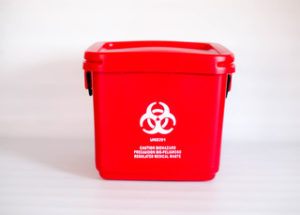Comprehending the Different Sorts Of Waste Disposal Methods
In the realm of waste monitoring, the selection of disposal techniques offered today is huge and differed, each approach serving a distinct function in attending to the obstacle of garbage disposal. click here. From recycling approaches that intend to give new life to products, to the detailed procedures of contaminated materials administration, the landscape of garbage disposal is complex yet vital for ecological sustainability. Understanding the nuances of these different methods not just sheds light on the significance of accountable waste administration yet additionally motivates us to reassess our approach towards waste disposal in a quickly progressing globe

Recycling Methods
Recycling approaches are essential for lasting waste administration methods in both household and commercial settings. medical waste disposal. By carrying out efficient recycling approaches, a considerable amount of waste can be drawn away from landfills, preserving natural deposits and decreasing the ecological impact of manufacturing processes
In suburbs, curbside recycling programs play a crucial role in motivating households to different recyclable products from general waste. Materials such as paper, plastics, glass, and steels can be sorted and gathered for handling into brand-new items, decreasing the demand for resources and energy-intensive production processes.
Industrial facilities likewise rely upon recycling approaches to minimize waste generation and promote a round economy. By executing closed-loop systems, organizations can reuse materials within their production procedures, reducing prices and environmental footprint. medical waste disposal. Additionally, industrial recycling programs usually involve partnerships with specialized recycling facilities to make sure that products are properly sorted, processed, and reintegrated into the supply chain
Composting Methods

Aerated fixed stack composting involves blending organic waste products in a big heap and consistently turning it to ensure correct aeration. This approach is efficient for large composting operations. On the various other hand, vermicomposting uses earthworms to damage down natural matter right into nutrient-rich spreadings. This technique is fit for smaller-scale operations and houses.
In-vessel composting involves positioning organic waste in a closed container with controlled conditions for temperature and oygenation. Windrow composting consists of forming long rows of natural waste and on a regular basis transforming them to promote decomposition - medical waste removal.
Landfill Disposal
Garbage dump disposal is a commonly used approach for managing waste that can not be reused or composted. It entails burying waste in assigned locations of land, with proper safety measures to avoid environmental contamination. Garbage dumps are crafted centers designed to isolate waste from the surrounding setting. The waste is compressed and covered with soil everyday to minimize smells, deter insects, and lessen the spread of clutter. Modern landfills are geared up with protective linings and monitoring systems to avoid leakage of unsafe substances into the soil and groundwater. Methane gas, a by-product of disintegrating natural waste in land fills, is usually collected and used as a source of renewable energy. Despite improvements in garbage dump modern technology, worries continue to be concerning the lasting ecological influences, such as groundwater contamination and greenhouse gas exhausts. Initiatives to minimize dependence on garbage dumps include advertising waste reduction, recycling, and checking out alternate waste disposal techniques to reduce the environmental footprint associated with traditional land fill disposal techniques.

Waste-to-Energy Incineration
Incineration of waste for energy generation is a technique significantly being considered as an option to typical landfill disposal methods. Waste-to-energy incineration entails the burning of waste materials at high temperatures, normally in specialized centers designed to produce electrical energy or warmth through the process - click here. This technique not only minimizes the quantity of waste that would otherwise be predestined for landfills but likewise uses the heat produced during incineration to produce power
Among the key advantages of waste-to-energy incineration is its capability to create electricity while reducing the environmental effect contrasted to standard land fill disposal methods. By converting waste into energy, this approach helps in minimizing greenhouse gas discharges and dependence on nonrenewable fuel sources for power generation. In addition, waste-to-energy centers are equipped with advanced air pollution control technologies to mitigate potential environmental pollutants released during the burning procedure.
Contaminated Materials Monitoring

Thinking about the crucial significance of responsible waste monitoring techniques, especially in the realm of ecological sustainability, the emphasis now shifts in the direction of the article complex domain of Hazardous Waste Monitoring. Harmful waste positions significant threats to both human health and wellness and the atmosphere, necessitating customized handling and disposal methods. Common instances of contaminated materials consist of chemicals, batteries, pesticides, and electronic waste.
Unsafe Waste Monitoring includes the recognition, collection, transport, therapy, and disposal of materials deemed potentially dangerous or hazardous. This process requires adherence to strict policies and guidelines to alleviate damaging effect on environments and public health. Different methods are used in handling harmful waste, including recycling, safe landfills, encapsulation, and chemical therapy.
Proper Contaminated Materials Monitoring is important for stopping contamination of dirt, water resources, and air pollution. It is crucial for markets, labs, medical care facilities, and various other generators of hazardous waste to implement robust administration methods, training programs, and emergency situation action plans to make certain the risk-free handling and disposal of these materials. Failing to take care of contaminated materials properly can have far-ranging consequences, emphasizing the importance of attentive and accountable methods in this area.
Conclusion
Finally, garbage disposal methods play a critical role in handling and minimizing the impact of waste on the atmosphere. From reusing and composting to land fill disposal and waste-to-energy incineration, each technique has its very own benefits and limitations. Appropriate administration of hazardous waste is additionally important to safeguard public wellness and the setting. It is essential for industries and people to comprehend the different garbage disposal methods offered and select the most ideal approach for lasting waste administration.
In the realm of waste monitoring, the selection of disposal techniques readily available today is substantial and differed, each approach offering a distinct function in attending to the challenge of waste disposal. click here. From reusing methods that aim to provide new life to products, to the complex procedures of hazardous waste administration, the landscape of waste disposal is complicated yet crucial for environmental sustainability. Comprehending the subtleties of these various methods not only drops light on the relevance of liable waste management yet likewise prompts us to reassess our approach towards waste disposal in a swiftly advancing world
Initiatives to lower reliance on garbage dumps include promoting waste reduction, recycling, and discovering different waste disposal techniques to lessen the ecological footprint connected with standard land fill disposal techniques.
It is vital for sectors and people to recognize the different waste disposal strategies readily available and pick the most appropriate technique for sustainable waste management.